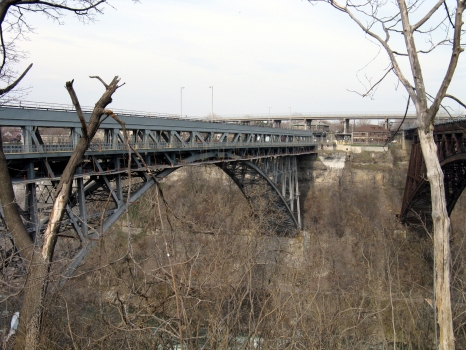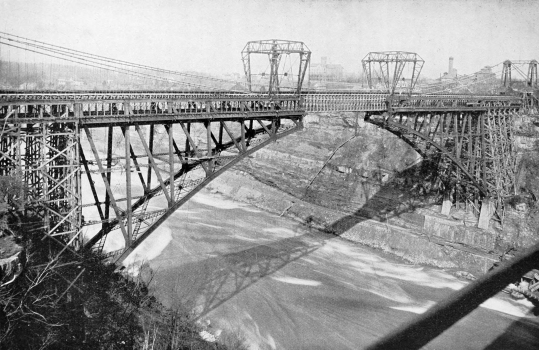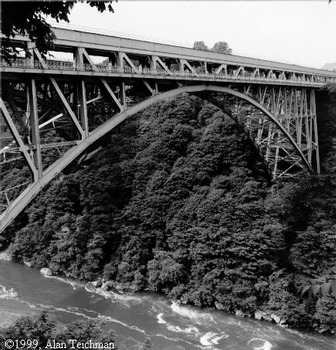General Information
| Other name(s): | Lower Arch Bridge; Niagara Railroad Arch |
|---|---|
| Beginning of works: | 1896 |
| Completion: | 1897 |
| Status: | in use |
Project Type
| Structure: |
Two-hinged arch bridge |
|---|---|
| Material: |
Steel bridge |
| Structure: |
Deck arch bridge |
| Support conditions: |
for registered users |
| Plan view: |
Structurae Plus/Pro - Subscribe Now! |
| Function / usage: |
upper deck: Railroad (railway) bridge lower deck: Road bridge |
Location
| Location: |
Niagara Falls, Niagara County, New York, USA Niagara Falls, Ontario, Canada |
|---|---|
| Crosses: |
|
| Replaces: |
Niagara Falls Suspension Bridge (1855)
|
| Coordinates: | 43° 6' 31" N 79° 3' 28.61" W |
Technical Information
Dimensions
| main span | 167.6 m | |
| total length | 329 m | |
| arch | rise | 34.7 m |
| deck | height of upper deck above water | 68.6 m |
| lower deck | width | 16.9 m |
| upper deck | width | 10 m |
| number of tracks | 1 |
Quantities
| structural steel | 3 266 t |
Materials
| arch |
steel
|
|---|
Chronology
| 9 April 1896 | Foundation work begins |
|---|---|
| 29 July 1897 | Testing with a live load of 9673 kg/m. Resulting deflection: 17.5 mm. |
| 27 August 1897 | Completion of all work |
Notes
This arch bridge replaced John Roebling's famous Niagara Railway Suspension Bridge, and was built on the same centerline. Construction was completed without interruption of scheduled railroad traffic.
This toll bridge is currently administered by the Niagara Falls Bridge Commission.
Excerpt from Wikipedia
The Whirlpool Rapids Bridge, commonly known as the Whirlpool Bridge or the Lower Steel Arch Bridge (before 1937), is a spandrel braced, riveted, two-hinged arch bridge. It crosses the international border between Canada and the United States, connecting the commercial downtown districts of Niagara Falls, Ontario and Niagara Falls, New York. This bridge is located approximately 1.5 kilometres (0.9 mi) north of the Rainbow Bridge and about 2 kilometres (1.2 mi) from the Falls. It was acquired by the Niagara Falls Bridge Commission in January 1959. Immediately up stream is the similar arch-style Michigan Central Railway Bridge, which has been out-of-service since 2001.
History
The predecessor of the Whirlpool Rapids Bridge was the Niagara Falls Suspension Bridge, which carried foot and rail traffic. That bridge, opened in 1855, was most notable for being the world's first working railway suspension bridge and for being the bridge abolitionists running the Underground Railroad used to get slaves to freedom in Canada. By the late 1800s, the suspension bridge was becoming outdated for railroad needs. The weight of trains in North America had greatly increased by the mid-1890s. Larger and more powerful locomotives were required to pull cars that handled an increasing number of passengers and goods; compared to the 23-short-ton (21 t) locomotives crossing the bridge in the 1850s, 170-short-ton (150 t) locomotives were the common engines 40 years later. The weight of these trains exceeded the specifications of the Suspension Bridge, and the bridge companies took the opportunity to review and request the replacement of the bridge.
Civil engineer Leffert L. Buck, who had been hired to maintain the Suspension Bridge, was selected to design the replacement bridge. He settled for a bridge of the arch design. At that time, arch bridges were the new models for railway bridges and were more cost-efficient than suspension bridges. Buck built the new bridge around and below the Suspension Bridge, replacing it a piece at a time beginning on April 9, 1896. His plan allowed bridge traffic—train and pedestrian—to continue without disruption. By August 27, 1897, the last pieces of the Suspension Bridge were dismantled, leaving the Lower Steel Arch Bridge—later renamed the Whirlpool Rapids Bridge—in its stead.
Over the years the New York Central Railroad, Great Western Railway, Erie Railroad, Canadian National Railway, and Amtrak have used the bridge. In November 2009, the bridge was extensively refurbished: repairing and replacing the catwalk and some of the steel beams and rivets, sandblasting, and a paint job were among the major maintenance tasks undertaken. Amtrak took over maintenance responsibility of the rail deck from Canadian National (CN) in late 2012. Currently the Maple Leaf train service, jointly operated by Amtrak and Via Rail, is the only train to use the bridge; CN routes freight over the International Railway Bridge at Fort Erie, Ontario–Buffalo, New York instead.
Just upstream is the disused Michigan Central Railway Bridge which with its predecessor the Niagara Cantilever Bridge competed for rail traffic with the Whirlpool Rapids Bridge.
Bridge setup
The bridge has two decks. The upper deck carries the railway traffic while the lower deck is a roadway.
It is a preferred crossing for residents of the Niagara region as the lower deck roadway is reserved for passenger vehicles only—commercial vehicles and pedestrians are prohibited. The bridge may only be used by members of the NEXUS trusted traveller program, jointly operated by the Canada Border Services Agency (CBSA) and United States Customs and Border Protection (CBP), with crossers paying a toll electronically using an account linked to their NEXUS card. There is one lane of traffic to the United States and one lane to Canada, with two inspection lanes at each end for traffic entering the respective countries. The American side connects to New York State Route 104 and New York State Route 182, while the Canadian side connects to the historic terminus of Highway 3A, Highway 8 and Highway 20, now known as River Road and Bridge Street.
A single train track crosses over the bridge on the upper deck. The track is currently used exclusively by Amtrak trains for the Maple Leaf international train service between Toronto and New York City. The Via Rail Niagara Falls Station is immediately located on the Canadian side of the bridge in Niagara Falls, Ontario and the Amtrak Niagara Falls Station is immediately located on the American side of the bridge in Niagara Falls, New York.
Text imported from Wikipedia article "Whirlpool Rapids Bridge" and modified on November 30, 2020 according to the CC-BY-SA 4.0 International license.
Participants
- Leffert Lefferts Buck (engineer)
Relevant Web Sites
Relevant Publications
- (1911): History of Bridge Engineering. Chicago (USA), pp. 340-341.
- (1898): The Niagara Railway Arch. In: Transactions of the American Society of Civil Engineers, v. 40 ( 1898), pp. 125-177 (#836).
- (1919): Revisions of the Niagara Railway Arch Bridge. In: Transactions of the American Society of Civil Engineers, v. 83, n. 1 ( 1919), pp. 1919-99, 200-2025.
- (1999): Tierra sobre el agua. Visión histórica universal de los puentes. Colegio de Ingenieros de Caminos, Canales y Puertos, Madrid (Spain), pp. 335.
- About this
data sheet - Structure-ID
20000652 - Published on:
02/04/2000 - Last updated on:
07/05/2024







